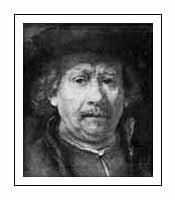
Rembrandt van Rijn (1606 – 1669)
Dutch Golden Age painter, printmaker and draughtsman Rembrandt was born on 15 July 1606 in Leiden, in the Dutch Republic, now the Netherlands. As a boy, he attended a Latin school. At the age of 13, he was enrolled at the University of Leiden, although according to a contemporary he had a greater inclination towards painting. In 1624 or 1625, Rembrandt opened a studio in Leiden, which he shared with friend and colleague Jan Lievens. In 1627, Rembrandt began to accept students, which included Gerrit Dou in 1628 and Isaac de Jouderville.
At the end of 1631, Rembrandt moved to Amsterdam, a city rapidly expanding as the business and trade capital. He began to practice as a professional portraitist for the first time, with great success. He initially stayed with an art dealer, Hendrick van Uylenburgh, and in 1634, married Hendrick’s cousin, Saskia van Uylenburgh.
Throughout his career, Rembrandt took as his primary subjects the themes of portraiture, landscape and narrative painting. For the last, he was especially praised by his contemporaries, who extolled him as a masterly interpreter of biblical stories for his skill in representing emotions and attention to detail.
Themes and Styles
A parallel development may be seen in Rembrandt’s skill as a printmaker. In the etchings of his maturity, particularly from the late 1640s onward, the freedom and breadth of his drawings and paintings found expression in the print medium as well. The works encompass a wide range of subject matter and technique, sometimes leaving large areas of white paper to suggest space, at other times employing complex webs of line to produce rich dark tones. Rembrandt never went abroad but was considerably influenced by the work of the Italian masters and Dutch artists. In his works, he exhibited knowledge of classical iconography.
In the 1650s, Rembrandt’s style changed again. Colors became richer and brush strokes more pronounced. With these changes, Rembrandt distanced himself from earlier work and current fashion, which increasingly inclined toward fine, detailed works. His use of light becomes more jagged and harsh, and shine becomes almost nonexistent. Contemporary accounts sometimes remark disapprovingly of the coarseness of Rembrandt’s brushwork. The artist himself was said to have dissuaded visitors from looking too closely at his paintings.
A List of important works of the Artist. Visit the gallery with large-size images, date, size, location and technical information.
References
